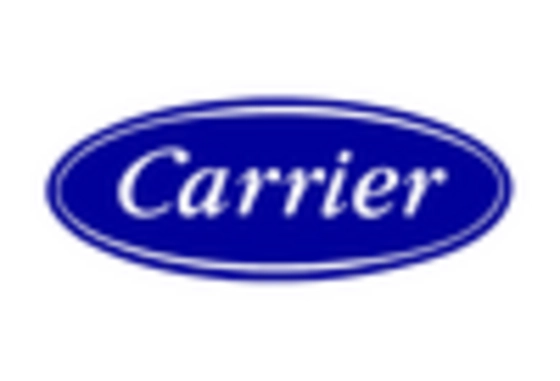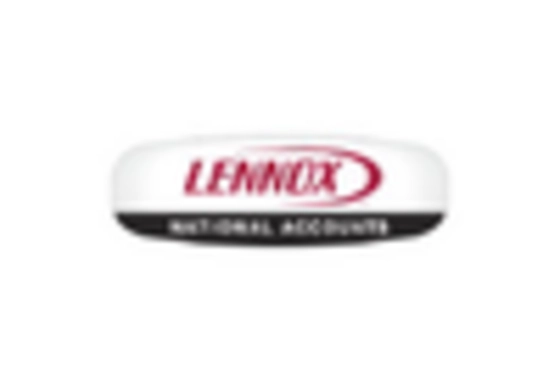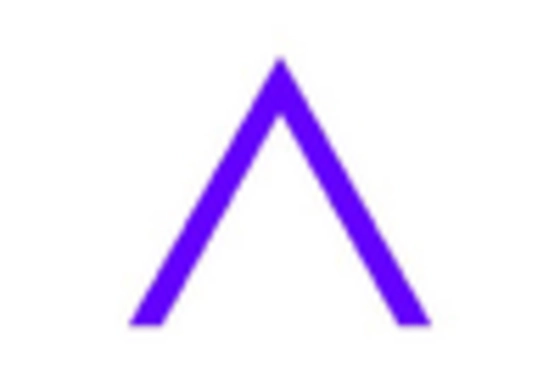Shift Towards Renewable Energy Sources
The transition towards renewable energy sources is reshaping the Residential Heating Equipment Market. As more consumers and businesses seek sustainable heating solutions, there is a growing interest in systems that utilize renewable energy, such as solar thermal heating and biomass boilers. This shift is driven by both environmental concerns and the potential for long-term cost savings. Data suggests that the adoption of renewable heating technologies could reduce greenhouse gas emissions significantly, aligning with global sustainability goals. As a result, the market for renewable heating solutions is expected to expand, reflecting a broader trend towards eco-friendly practices in the Residential Heating Equipment Market.
Regulatory Support for Energy Efficiency
Government regulations aimed at promoting energy efficiency are significantly influencing the Residential Heating Equipment Market. Many countries have implemented stringent energy efficiency standards for heating equipment, encouraging manufacturers to innovate and produce more efficient products. For instance, regulations may require new heating systems to meet specific energy performance criteria, which can lead to increased adoption of high-efficiency models. This regulatory environment not only supports environmental sustainability but also provides consumers with long-term cost savings on energy bills. As a result, the market for energy-efficient heating solutions is projected to expand, reflecting a growing consumer preference for compliant products in the Residential Heating Equipment Market.
Increasing Consumer Awareness of Energy Costs
Consumer awareness regarding energy costs is a driving force in the Residential Heating Equipment Market. As energy prices fluctuate, homeowners are becoming more conscious of their heating expenses and are seeking solutions that offer better efficiency and lower operational costs. This heightened awareness is prompting consumers to invest in modern heating systems that promise reduced energy consumption. Market data indicates that energy-efficient heating equipment can lead to savings of up to 20% on annual heating costs. Consequently, the demand for such products is likely to increase, as consumers prioritize cost-effective solutions in their purchasing decisions within the Residential Heating Equipment Market.
Rising Construction and Renovation Activities
The ongoing rise in construction and renovation activities is positively impacting the Residential Heating Equipment Market. As new residential buildings are constructed and existing homes undergo renovations, there is an increasing demand for modern heating systems that meet contemporary standards of efficiency and comfort. Market analysis indicates that the construction sector is projected to grow steadily, leading to a corresponding increase in the installation of advanced heating equipment. This trend is further fueled by consumer preferences for energy-efficient and smart heating solutions, which are often integrated into new builds. Consequently, the Residential Heating Equipment Market is likely to benefit from this surge in construction and renovation projects.
Technological Advancements in Heating Systems
The Residential Heating Equipment Market is experiencing a notable shift due to rapid technological advancements. Innovations such as smart thermostats, energy-efficient boilers, and heat pumps are becoming increasingly prevalent. These technologies not only enhance user convenience but also improve energy efficiency, which is a critical factor for consumers. According to recent data, the integration of smart technology in heating systems has led to a reduction in energy consumption by up to 30%. This trend is likely to continue as manufacturers invest in research and development to create more sophisticated heating solutions. As a result, the demand for advanced heating equipment is expected to rise, driving growth in the Residential Heating Equipment Market.


















Leave a Comment